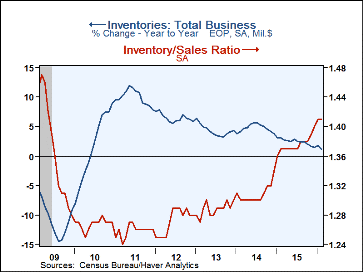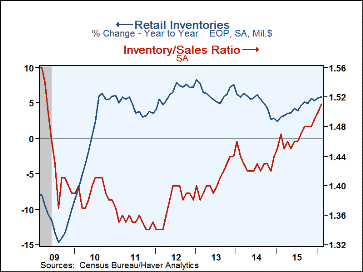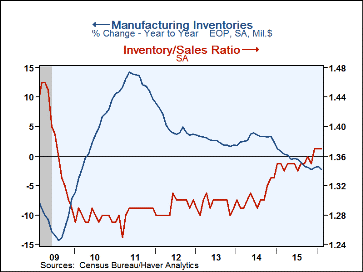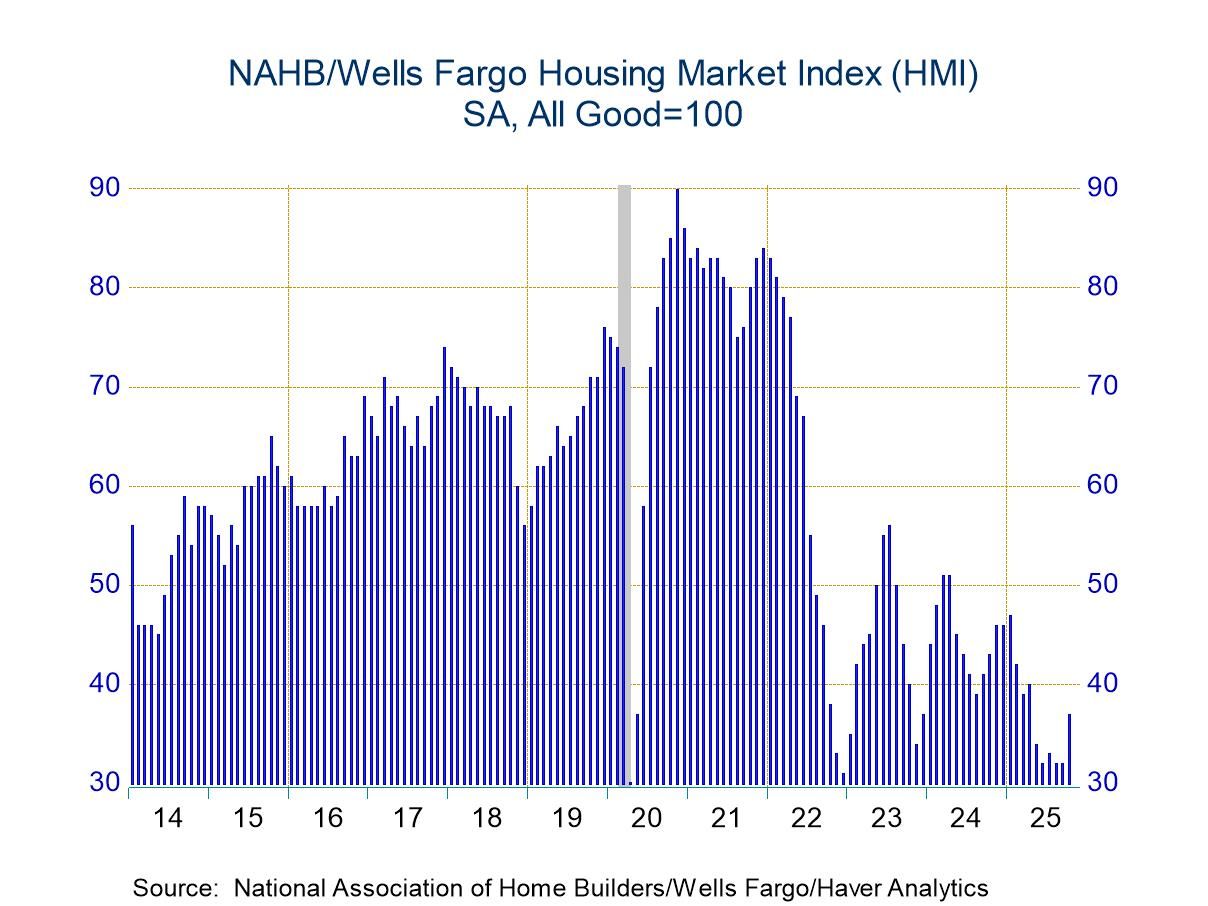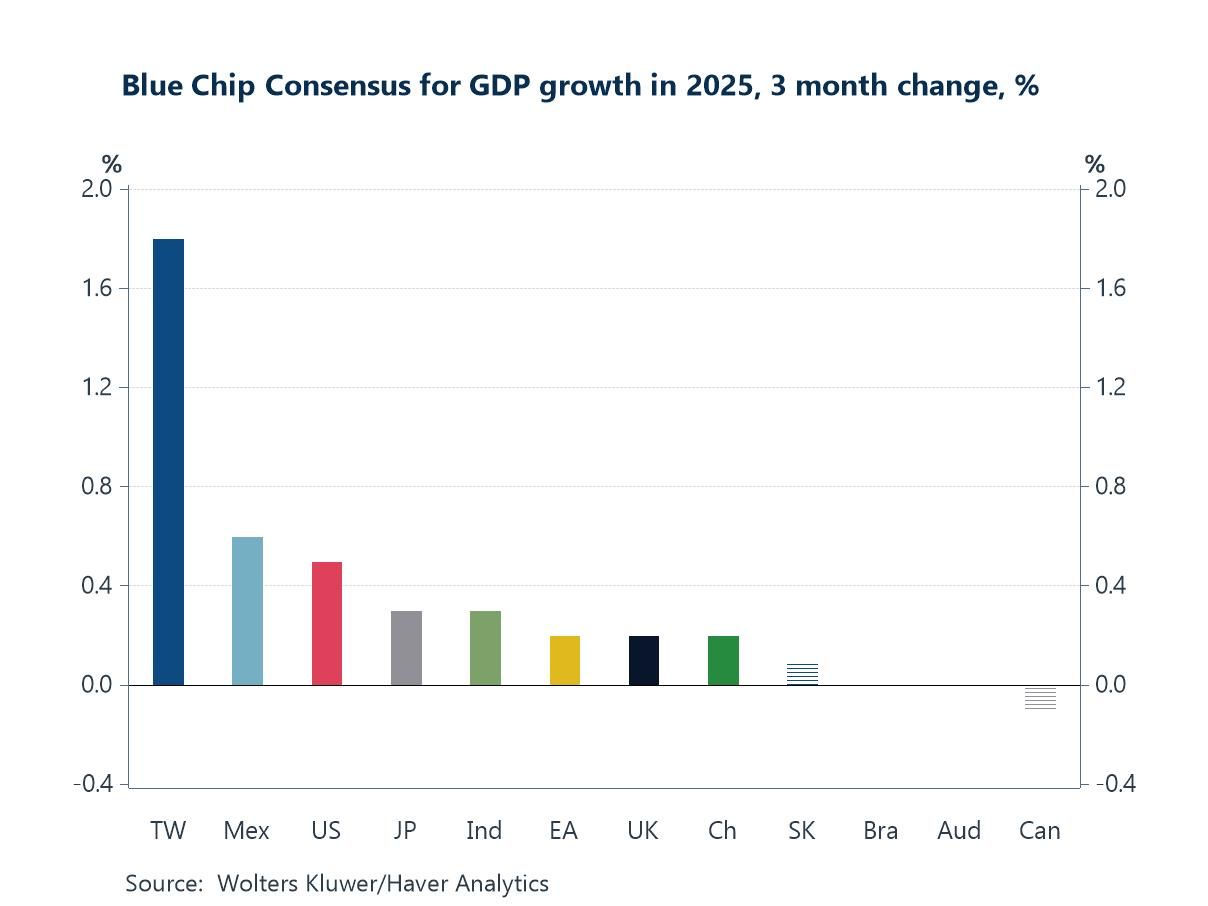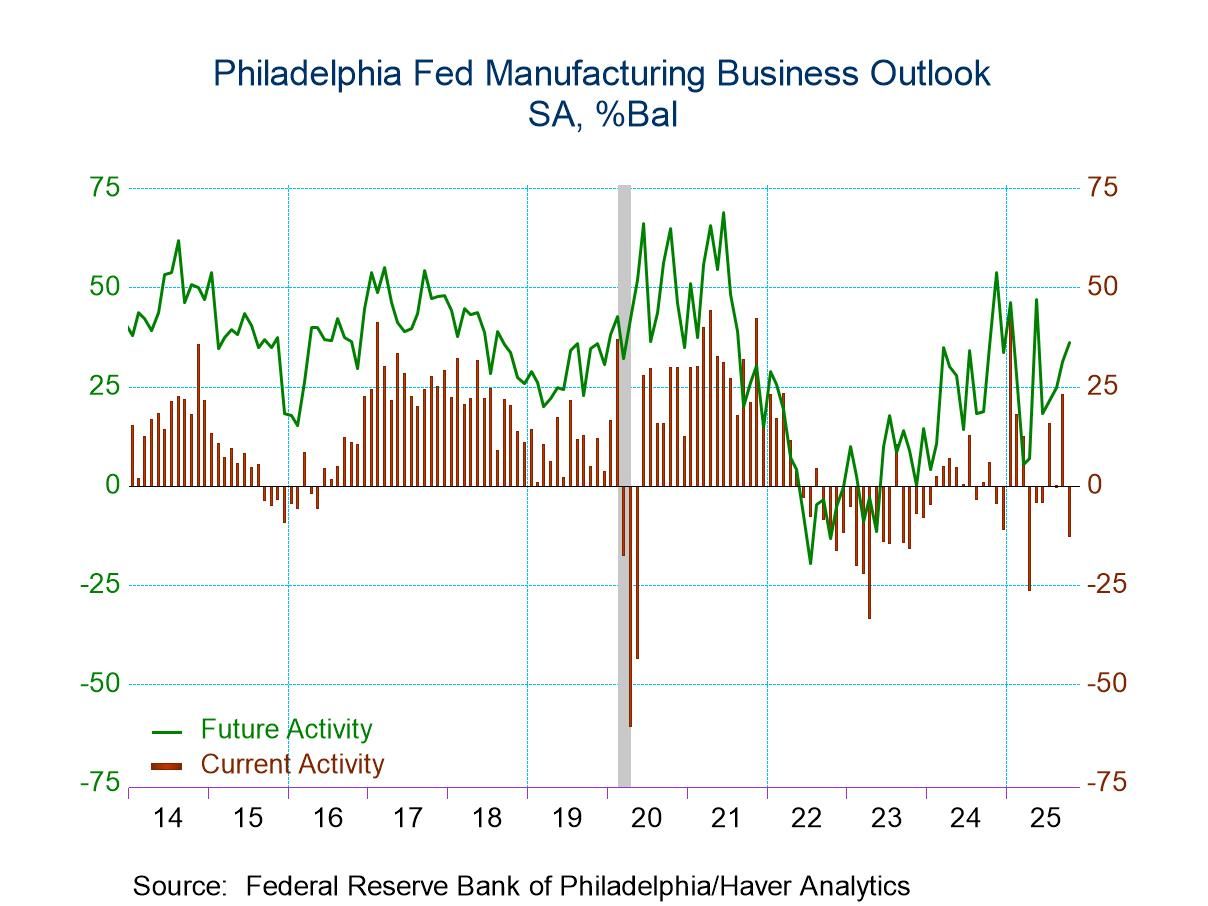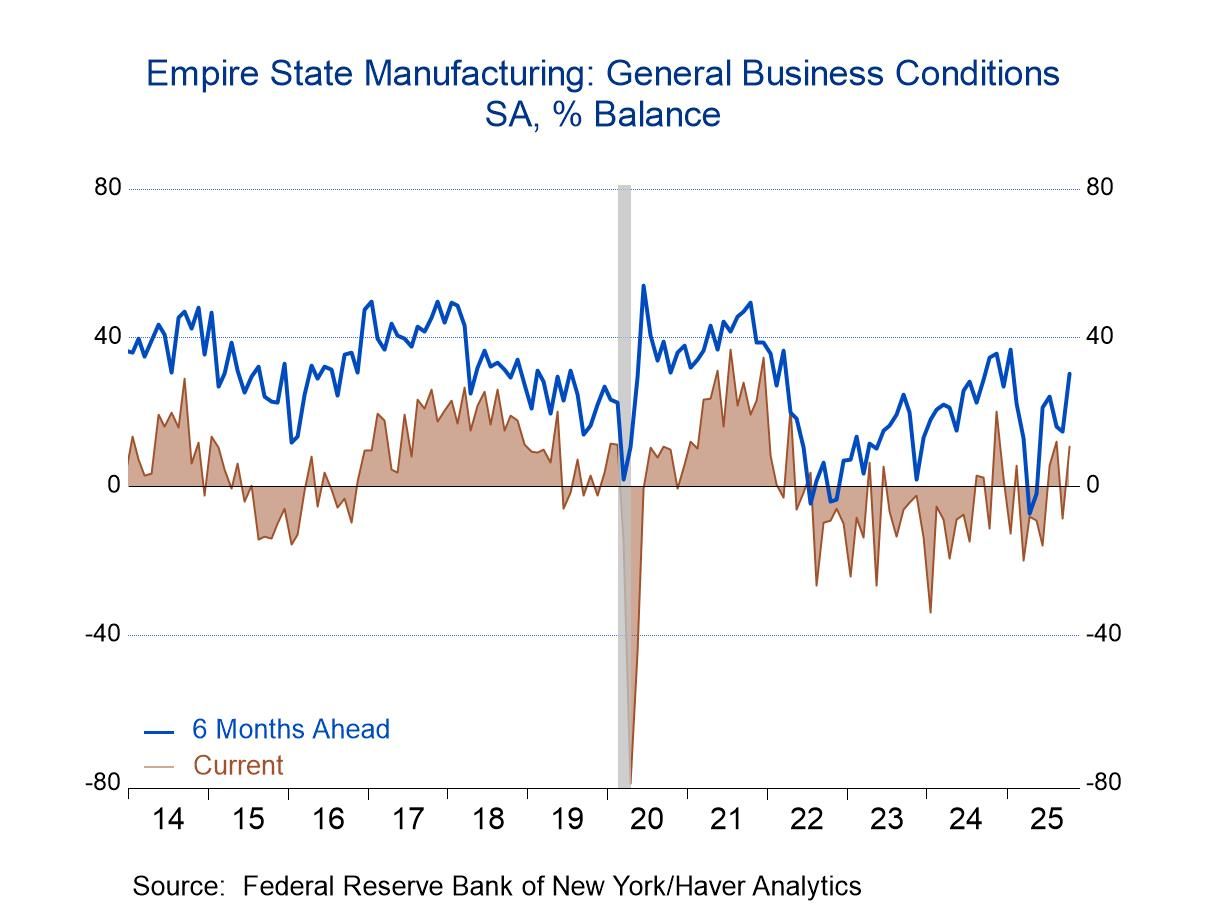 Global| Apr 13 2016
Global| Apr 13 2016U.S. Business Inventories & Sales Ease
by:Tom Moeller
|in:Economy in Brief
Summary
Total business inventories edged 0.1% lower m/m (+1.2% y/y) during February following a 0.1% dip in January, revised from +0.1%. Total business sales fell 0.4% m/m (-1.4% y/y), the seventh consecutive month of decline. Retail [...]
Total business inventories edged 0.1% lower m/m (+1.2% y/y) during February following a 0.1% dip in January, revised from +0.1%. Total business sales fell 0.4% m/m (-1.4% y/y), the seventh consecutive month of decline.
Retail inventories increased 0.6% (5.9% y/y) following a 0.4% rise, revised from 0.3%. Motor vehicle & parts inventories declined 2.1% (+1.4% y/y) following four months of little change. Outside of the vehicle sector, retail inventories gained 0.4% (1.2% y/y), after two months of decline. Furniture & home furnishings inventories rose 0.2% (0.6% y/y) following a 0.1% dip. Clothing inventories declined 0.9% (+0.1% y/y) after a 0.3% rise. Building materials inventories jumped 1.4% (10.8% y/y), the same as during the prior month. General merchandise store inventories gained 0.5% (1.2% y/y) after two months of decline. Food & beverage store inventories remained unchanged (1.2% y/y) for a second month.
Merchant wholesale inventories fell 0.5% (+0.6% y/y), the fifth consecutive month of decline. Inventories in the manufacturing sector continued a lengthy decline and were down 0.4% (-2.3% y/y).
Overall business sales fell 0.4% (-1.4% y/y). Retail sales were off 0.2% (+3.1% y/y) after a 0.3% decline. Wholesale sales dropped 0.2% (-3.1% y/y), down sharply for the fourth straight month, and factory sector shipments declined 0.7% (-3.5% y/y) following seven straight months of decline.
The inventory-to-sales ratio in the business sector remained at 1.41, the highest level since August 2009. The ratio in the retail sector moved to a recovery high of 1.51 while excluding autos it also moved to a recovery high of 1.31. The I/S ratio in the clothing sector of 2.56 and 2.14 in the motor vehicle sector exceeded the 1.49 ratio amongst general merchandisers. Food & beverage stores maintained a ratio of 0.80. Merchant wholesales were near a cycle high of 1.36 while manufacturers' ratio was steady m/m at 1.37.
The manufacturing and trade data are in Haver's USECON database.
| Manufacturing & Trade (%) | Feb | Jan | Dec | Feb Y/Y | 2015 | 2014 | 2013 |
|---|---|---|---|---|---|---|---|
| Business Inventories | -0.1 | -0.1 | 0.0 | 1.2 | 1.6 | 3.9 | 4.3 |
| Retail | 0.6 | 0.4 | 0.4 | 5.9 | 5.3 | 2.8 | 7.6 |
| Retail excl. Motor Vehicles | 0.3 | 0.2 | 0.2 | 4.2 | 4.4 | 2.2 | 4.9 |
| Merchant Wholesalers | -0.5 | -0.2 | -0.2 | 0.6 | 2.0 | 6.9 | 4.2 |
| Manufacturing | -0.4 | -0.5 | -0.2 | -2.3 | -1.9 | 2.4 | 1.7 |
| Business Sales (%) | |||||||
| Total | -0.4 | -0.8 | -0.6 | -1.4 | -2.4 | 3.4 | 3.0 |
| Retail | -0.2 | -0.3 | 0.2 | 3.1 | 1.5 | 3.6 | 3.9 |
| Retail excl. Motor Vehicles | -0.3 | -0.2 | 0.2 | 1.8 | -0.2 | 2.5 | 2.7 |
| Merchant Wholesalers | -0.2 | -1.9 | -0.3 | -3.1 | -3.6 | 4.4 | 3.1 |
| Manufacturing | -0.7 | -0.2 | -1.4 | -3.5 | -4.2 | 2.5 | 2.1 |
| I/S Ratio | |||||||
| Total | 1.41 | 1.41 | 1.40 | 1.37 | 1.37 | 1.31 | 1.29 |
| Retail | 1.51 | 1.50 | 1.49 | 1.47 | 1.47 | 1.43 | 1.41 |
| Retail Excl. Motor Vehicles | 1.31 | 1.30 | 1.30 | 1.28 | 1.28 | 1.24 | 1.23 |
| Merchant Wholesalers | 1.36 | 1.37 | 1.34 | 1.31 | 1.30 | 1.20 | 1.18 |
| Manufacturing | 1.37 | 1.37 | 1.37 | 1.35 | 1.35 | 1.31 | 1.30 |
Tom Moeller
AuthorMore in Author Profile »Prior to joining Haver Analytics in 2000, Mr. Moeller worked as the Economist at Chancellor Capital Management from 1985 to 1999. There, he developed comprehensive economic forecasts and interpreted economic data for equity and fixed income portfolio managers. Also at Chancellor, Mr. Moeller worked as an equity analyst and was responsible for researching and rating companies in the economically sensitive automobile and housing industries for investment in Chancellor’s equity portfolio. Prior to joining Chancellor, Mr. Moeller was an Economist at Citibank from 1979 to 1984. He also analyzed pricing behavior in the metals industry for the Council on Wage and Price Stability in Washington, D.C. In 1999, Mr. Moeller received the award for most accurate forecast from the Forecasters' Club of New York. From 1990 to 1992 he was President of the New York Association for Business Economists. Mr. Moeller earned an M.B.A. in Finance from Fordham University, where he graduated in 1987. He holds a Bachelor of Arts in Economics from George Washington University.


